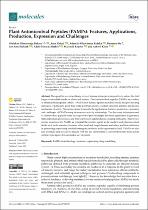| dc.contributor.author | Bakare, Olalekan Olanrewaju | |
| dc.contributor.author | Gokul, Arun | |
| dc.contributor.author | Fadaka, Adewale Oluwaseun | |
| dc.date.accessioned | 2022-09-19T07:42:27Z | |
| dc.date.available | 2022-09-19T07:42:27Z | |
| dc.date.issued | 2022 | |
| dc.identifier.citation | Bakare, O. O. et al. (2022). Plant antimicrobial peptides (pamps): Features, applications, production, expression and challenges. Molecules, 27(12), 3703. https://doi.org/10.3390/molecules27123703 | en_US |
| dc.identifier.issn | 1420-3049 | |
| dc.identifier.uri | https://doi.org/10.3390/molecules27123703 | |
| dc.identifier.uri | http://hdl.handle.net/10566/7905 | |
| dc.description.abstract | The quest for an extraordinary array of defense strategies is imperative to reduce the challenges
of microbial attacks on plants and animals. Plant antimicrobial peptides (PAMPs) are a subset
of antimicrobial peptides (AMPs). PAMPs elicit defense against microbial attacks and prevent drug
resistance of pathogens given their wide spectrum activity, excellent structural stability, and diverse
mechanism of action. This review aimed to identify the applications, features, production, expression,
and challenges of PAMPs using its structure–activity relationship. The discovery techniques used
to identify these peptides were also explored to provide insight into their significance in genomics,
transcriptomics, proteomics, and their expression against disease-causing pathogens. | en_US |
| dc.language.iso | en | en_US |
| dc.publisher | MDPI | en_US |
| dc.subject | Biotechnology | en_US |
| dc.subject | Engineering | en_US |
| dc.subject | Drugs | en_US |
| dc.subject | Plants | en_US |
| dc.subject | Pathogens | en_US |
| dc.title | Plant antimicrobial peptides (pamps): Features, applications, production, expression and challenges | en_US |
| dc.type | Article | en_US |

